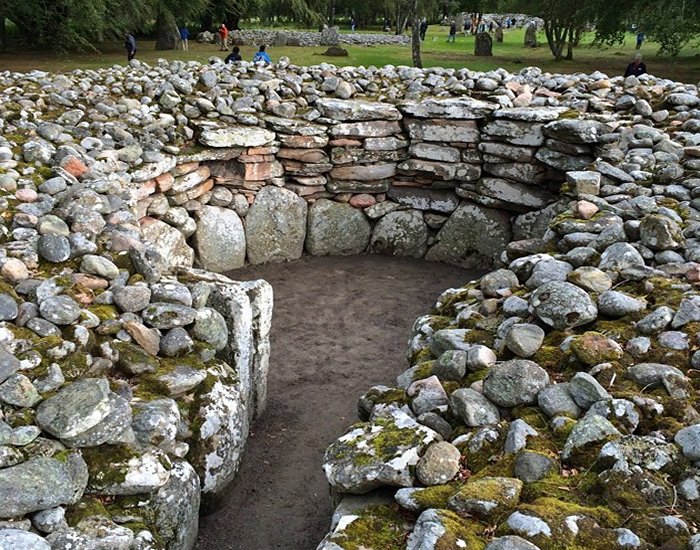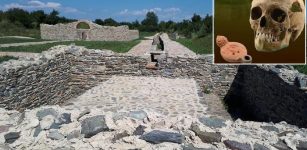4,000-Year-Old Scottish Clava Cairns Were Built To House Dead
A. Sutherland - AncientPages.com - The Clava Cairns are located near Inverness, a city in the Scottish Highlands. According to no published excavations, the dates for the Clava monuments are thought to belong to the Late Neolithic or Early Bronze Age (about 2500 - 1700 BC).
As explained in the book "How to read prehistoric monuments" by Alan Butler, "the Scottish examples, especially the ones around Inverness, are often called ‘Clava Cairns’, though in fact this name refers to three specific cairn burials at Balnuaran of Clava, Inverness.
Balnuaran of Clava contains (three tombs), Inverness, Scotland and they were first used around
2000 BC and then again in 1000 BC.

For millennia, this cemetery (and also a smaller one in the vicinity, at Milton of Clava) remained sacred places for the Bronze Age peoples, who conducted there their burial activities and rituals.
There are two different types of cairn tombs in Scotland. One variety is a corbelled passage grave (Corbelled Tomb) and Passage Grave with a single chamber and a short entrance passage.
The passage usually faces southwest (towards midwinter sunset). The other type of cairn tomb had noapparent entrance and no specifically created roof to the chamber. It is, essentially a ring of stones.Cairn tombs are invariably surrounded by a series of standing stones, and a kerb of stones often also surrounds the cairn..."
See also:
Largest Collection Of Ancient “Cup-Marked” Rocks Ever Found In Scotland
Brochs: Ingeniously Engineered Windowless Iron Age Structures Of North And West Scotland
Incredible 5,000-Year-Old Temple Complex In Orkney Could Re-Write History Of Scotland
For millennia, this cemetery (and also a smaller one in the vicinity, at Milton of Clava) remained sacred places for the Bronze Age peoples, who conducted there their burial activities and rituals.
The belief in an existence of an afterlife was widespread and deeply respected by the Bronze Age societies and was expressed by their funerary practices and additionally by ceremonial monuments which were constructed in Bronze Age Scotland.
These range from cairns built for the disposal of the dead to stone rows, stone circles and various different types of ‘hengiform’ monument (a very small henge-like structure, typically less than 15?m across). In many cases, these occurred in monument complexes that are likely to have spanned the third and second millennia BC.
At around 2000 BC a row of large cairns was built, three of which can still be seen today.
Excavations have found evidence for farming on the site before any of these monuments were built. Many of the stones used to construct the cairns have cup marks on them – these may have been reused from another place, perhaps an earlier sacred site.

Ancient Clava Cairns were built nearly 4,000 years ago in the Scottish Highlands near Inverness. Burials here were likely but much mystery remains. Guilded fountains with a castle towering above on a volcanic crag are part of what sets Edinburgh apart. Shot on assignment in Scotland aboard The Lord of the Glens with National Geographic Expeditions. @JimRichardsonNG @NatGeoTravel @NatGeo #scotland #iphonephoto (source)
Each cairn is surrounded by a circle of standing stones. The three prominent cairns form a line running north-east to south-west and also the passages of the two cairns are aligned towards the south-west, suggesting that the builders focused on eyes on the midwinter sunset.
Likewise, the location of the standing stones, especially the tallest ones is related to the setting sun in the south-west.
According to an ancient tradition, only one or two people were usually buried in each cairn, which could indicate that these resting places were used for particularly important persons in this Bronze Age society.
From the limited evidence available, it seems that the Clava cairns were not typical burial places
for communities, but for selected individuals, both male and female, which indicates that identity of these important personalities in the society was also celebrated in death.
These individuals were memorialized by the erection of the Clava cairns but also stone circles and small henges.
Written by – A. Sutherland - AncientPages.com Senior Staff Writer
Copyright © AncientPages.com All rights reserved. This material may not be published, broadcast, rewritten or redistributed in whole or part without the express written permission of AncientPages.com
Expand for referencesReferences:
More From Ancient Pages
-
 Remarkably Well-Preserved 2,500-Year-Old Canoe Discovered In Swiss Lake
Archaeology | Sep 16, 2023
Remarkably Well-Preserved 2,500-Year-Old Canoe Discovered In Swiss Lake
Archaeology | Sep 16, 2023 -
 World’s Oldest Toy Car – Could This 7500-Year-Old Discovery Be The Earliest Evidence Of The Wheel?
Artifacts | Sep 1, 2018
World’s Oldest Toy Car – Could This 7500-Year-Old Discovery Be The Earliest Evidence Of The Wheel?
Artifacts | Sep 1, 2018 -
 Ancient DNA Analysis Shows How The Rise And Fall Of The Roman Empire Shifted Populations In The Balkans
DNA | Dec 8, 2023
Ancient DNA Analysis Shows How The Rise And Fall Of The Roman Empire Shifted Populations In The Balkans
DNA | Dec 8, 2023 -
 10 Remarkable Ancient Indian Sages Familiar With Advanced Technology And Science Long Before Modern Era
Featured Stories | Oct 19, 2015
10 Remarkable Ancient Indian Sages Familiar With Advanced Technology And Science Long Before Modern Era
Featured Stories | Oct 19, 2015 -
 First Genetic Map Of People Of Ireland Is Presented By Irish, British And American Researchers
Archaeology | Dec 15, 2017
First Genetic Map Of People Of Ireland Is Presented By Irish, British And American Researchers
Archaeology | Dec 15, 2017 -
 Early Humans In The Hula Valley Invested In Systematic Procurement Of Raw Materials Hundreds Of Thousands Of Years Ago
Archaeology | Jul 19, 2023
Early Humans In The Hula Valley Invested In Systematic Procurement Of Raw Materials Hundreds Of Thousands Of Years Ago
Archaeology | Jul 19, 2023 -
 On This Day In History: Planet Neptune Officially Discovered – On Sep 23, 1846
News | Sep 23, 2016
On This Day In History: Planet Neptune Officially Discovered – On Sep 23, 1846
News | Sep 23, 2016 -
 Tree Rings On the Oregon Coast Show Evidence A Tsunami That Struck The Pacific Northwest In 1700
Archaeology | Sep 3, 2021
Tree Rings On the Oregon Coast Show Evidence A Tsunami That Struck The Pacific Northwest In 1700
Archaeology | Sep 3, 2021 -
 Mystery Why Vikings Left Greenland Has Been Solved By Scientists
Archaeology | Mar 23, 2022
Mystery Why Vikings Left Greenland Has Been Solved By Scientists
Archaeology | Mar 23, 2022 -
 DNA Study Of Ancient Humans Sheds Light On Human Evolution On The Tibetan Plateau
Archaeology | Mar 21, 2023
DNA Study Of Ancient Humans Sheds Light On Human Evolution On The Tibetan Plateau
Archaeology | Mar 21, 2023 -
 Rare Archaeological Discoveries In The Sacred Animal Necropolis In Saqqara
Archaeology | Apr 26, 2020
Rare Archaeological Discoveries In The Sacred Animal Necropolis In Saqqara
Archaeology | Apr 26, 2020 -
 How Did People Go To The Toilet In The Past Before The Invention Of The Flush Toilet?
Archaeology | Jun 10, 2023
How Did People Go To The Toilet In The Past Before The Invention Of The Flush Toilet?
Archaeology | Jun 10, 2023 -
 Ancestral Home Of All Humans Revealed Through World’s Largest Genome Reconstruction Of Our Ancestors
Archaeology | Jan 3, 2023
Ancestral Home Of All Humans Revealed Through World’s Largest Genome Reconstruction Of Our Ancestors
Archaeology | Jan 3, 2023 -
 Sweden’s Tanum And Skredsvik Petroglyphs: Thousands Of Spectacular And Intriguing Rock Art
Featured Stories | Aug 28, 2018
Sweden’s Tanum And Skredsvik Petroglyphs: Thousands Of Spectacular And Intriguing Rock Art
Featured Stories | Aug 28, 2018 -
 Golden Figurine From Yozgat Depicts Unknown Hittite God
Artifacts | May 11, 2016
Golden Figurine From Yozgat Depicts Unknown Hittite God
Artifacts | May 11, 2016 -
 Gold Coins Found In The Ancient City Of Notion Tell A Story Of Misfortune
Archaeology | Aug 9, 2024
Gold Coins Found In The Ancient City Of Notion Tell A Story Of Misfortune
Archaeology | Aug 9, 2024 -
 On This Day In History: Chinese General Koxinga Seizes The Island Of Taiwan – On Feb 1, 1662
News | Feb 1, 2017
On This Day In History: Chinese General Koxinga Seizes The Island Of Taiwan – On Feb 1, 1662
News | Feb 1, 2017 -
 Cacao Originated 1,500 Years Earlier Than Previously Thought And Comes From South America
Archaeology | Oct 30, 2018
Cacao Originated 1,500 Years Earlier Than Previously Thought And Comes From South America
Archaeology | Oct 30, 2018 -
 Ötzi The Iceman’s Stomach Bacteria And Complex History Of European Settlements
Archaeology | Jan 8, 2016
Ötzi The Iceman’s Stomach Bacteria And Complex History Of European Settlements
Archaeology | Jan 8, 2016 -
 Discovery: Massive Gawro Wall Dated To The Antique Age: Was It A Symbolic Or Defensive Structure?
Archaeology | Nov 9, 2019
Discovery: Massive Gawro Wall Dated To The Antique Age: Was It A Symbolic Or Defensive Structure?
Archaeology | Nov 9, 2019


